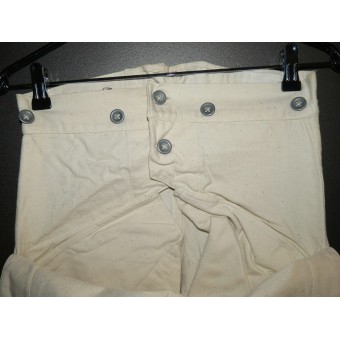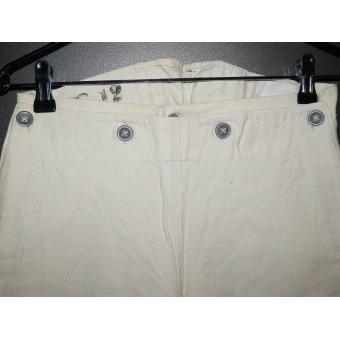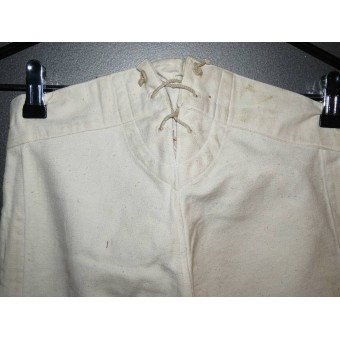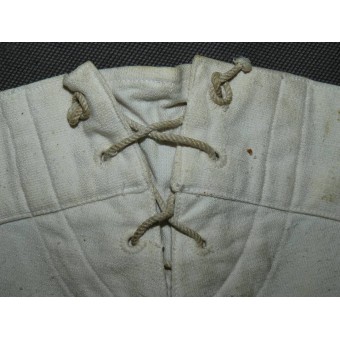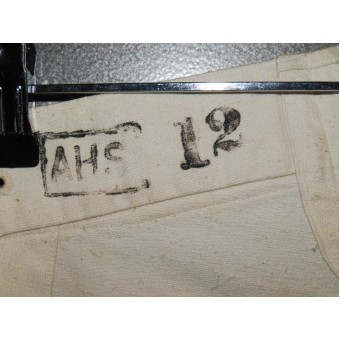Adolf Hitler Schule- AHS marcado marino Hitler Jugend pantalones de la marina de guerra
Esta es una traducción automática. Para ver el texto original en inglés haga clic aquí >>
Adolf Hitler Schule-Adolf Hitler School-AHS
The founding was based on Robert Ley's plan to erect a "Gauburg" (citadel) in every Gau, thereby creating an NSDAP school system. This would also have transformed the state-supported National-Political Educational Institutes. Education minister Bernhard Rust, however, agreed only to boarding school "Aufbauschulen" (advanced grade schools with some college preparation), supported by the party, to educate future party leaders. Neither plan was realized. Until 1941, the Adolf Hitler Schools were supported by the financial office of the German Labor Front. Built up class by class, the schools were housed with the similarly financed Order Fortresses until 1941. Responsibility for the schools' structure was assumed not by the NSDAP but by the Reichsjugendführer. The AHS were to set an example for the "revolution in education": “ The responsibility of youth for itself is also possible in school. — Baldur von Schirach ” Thus the Hitler Youth (HJ) announced its intent to transform schooling. Yet in practice the AHS achieved hardly more than the Education Institutes' model of a duplicate leadership structure for the boarding schools. HJ leaders and Order Fortress teachers were employed as "school leaders" (German: Schulführer); all had HJ ranks and were addressed familiarly with "Du". A Gauleiter did not supervise schools in his territory; this was done by a "commander" (Kommandeur) from the Youth Leadership. Thus with varied ambitions and usually little expertise, the "educators" worked on "educational and curricular plans". Only the plans for art and vocational education were published (1944). Unity was as meager in the effort to combine basic subjects in a Volkskunde (folklore) as it was in the content and introduction of such new subjects as "schooling in worldview" (sometimes called "NSDAP") or "religion lore". Denominational religious instruction was not offered. Latin ranked first as a foreign language. As in the Education Institutes, a broad range of athletic and musical offerings was guaranteed. Einsätze (action groups) were part of the educational theory in both kinds of schools and allowing pupils to "prove" themselves, usually in HJ leadership functions. The AHS gathered together for "performance weeks" (Leistungswochen). Beginning in 1941, the AHS became "Reich Schools of the NSDAP". (Only the Feldafing school, which since 1936 had been patronized and financed by the party leadership, was so designated.) After 1941 several AHS were housed in emptied sanatoriums and cloister schools. Assignment of pupils from an area to a particular school stopped at this point, and some German-speaking pupils from occupied territories were accepted. The disparate criteria according to which the HJ, under control of the local Gau leaders, had selected pupils thereby became more evident. The educational concept was based primarily on the individual's proving himself one of "the best". In 1941 the Education Ministry certified that the "final review" (Abschlussbeurteilung, conferred after five school years) qualified students for university study. Most pupils also received a diploma. A solid instructional program, for which there were no commonly accepted goals, was sacrificed to the idea of "proving oneself" (Bewährung). Within the five years, this was ultimately extended to the assumption of leadership positions in the Children's Country Evacuation, and, after 1943, to assignment as flak helpers. Graduates could choose their profession.
https://en.wikipedia.org/wiki/Adolf_Hitler_Schools
Esta es una traducción automática. Para ver el texto original en inglés haga clic aquí >>
Adolf Hitler Schule-Adolf Hitler School-AHS
The founding was based on Robert Ley's plan to erect a "Gauburg" (citadel) in every Gau, thereby creating an NSDAP school system. This would also have transformed the state-supported National-Political Educational Institutes. Education minister Bernhard Rust, however, agreed only to boarding school "Aufbauschulen" (advanced grade schools with some college preparation), supported by the party, to educate future party leaders. Neither plan was realized. Until 1941, the Adolf Hitler Schools were supported by the financial office of the German Labor Front. Built up class by class, the schools were housed with the similarly financed Order Fortresses until 1941. Responsibility for the schools' structure was assumed not by the NSDAP but by the Reichsjugendführer. The AHS were to set an example for the "revolution in education": “ The responsibility of youth for itself is also possible in school. — Baldur von Schirach ” Thus the Hitler Youth (HJ) announced its intent to transform schooling. Yet in practice the AHS achieved hardly more than the Education Institutes' model of a duplicate leadership structure for the boarding schools. HJ leaders and Order Fortress teachers were employed as "school leaders" (German: Schulführer); all had HJ ranks and were addressed familiarly with "Du". A Gauleiter did not supervise schools in his territory; this was done by a "commander" (Kommandeur) from the Youth Leadership. Thus with varied ambitions and usually little expertise, the "educators" worked on "educational and curricular plans". Only the plans for art and vocational education were published (1944). Unity was as meager in the effort to combine basic subjects in a Volkskunde (folklore) as it was in the content and introduction of such new subjects as "schooling in worldview" (sometimes called "NSDAP") or "religion lore". Denominational religious instruction was not offered. Latin ranked first as a foreign language. As in the Education Institutes, a broad range of athletic and musical offerings was guaranteed. Einsätze (action groups) were part of the educational theory in both kinds of schools and allowing pupils to "prove" themselves, usually in HJ leadership functions. The AHS gathered together for "performance weeks" (Leistungswochen). Beginning in 1941, the AHS became "Reich Schools of the NSDAP". (Only the Feldafing school, which since 1936 had been patronized and financed by the party leadership, was so designated.) After 1941 several AHS were housed in emptied sanatoriums and cloister schools. Assignment of pupils from an area to a particular school stopped at this point, and some German-speaking pupils from occupied territories were accepted. The disparate criteria according to which the HJ, under control of the local Gau leaders, had selected pupils thereby became more evident. The educational concept was based primarily on the individual's proving himself one of "the best". In 1941 the Education Ministry certified that the "final review" (Abschlussbeurteilung, conferred after five school years) qualified students for university study. Most pupils also received a diploma. A solid instructional program, for which there were no commonly accepted goals, was sacrificed to the idea of "proving oneself" (Bewährung). Within the five years, this was ultimately extended to the assumption of leadership positions in the Children's Country Evacuation, and, after 1943, to assignment as flak helpers. Graduates could choose their profession.
https://en.wikipedia.org/wiki/Adolf_Hitler_Schools





